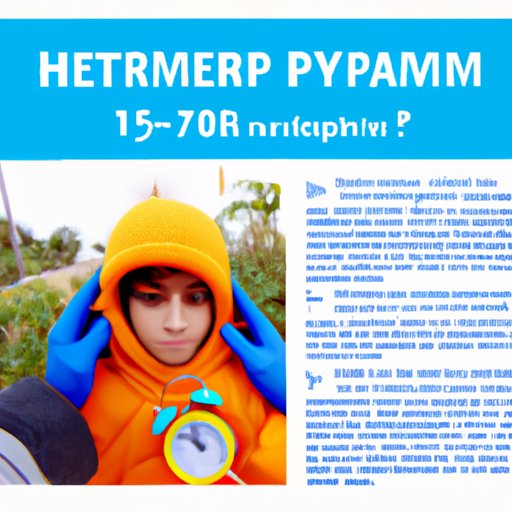Introduction
Hypothermia is a medical emergency that occurs when your body temperature drops below 95°F (35°C). It can be caused by prolonged exposure to cold temperatures or a combination of other factors, such as age, health conditions, and medications. In this article, we will explore how long it takes to develop hypothermia, investigate the risk factors, analyze the available treatments, and discuss ways to prevent this potentially life-threatening condition.

Examining How Long it Takes to Develop Hypothermia
The amount of time it takes for someone to develop hypothermia depends on a variety of factors, such as their environment, age, and health status. According to a study published in the journal Wilderness & Environmental Medicine, “In most cases, it takes several hours of exposure to low temperatures before signs and symptoms of hypothermia appear.”
It is important to note that there are three stages of hypothermia: mild, moderate, and severe. Mild hypothermia is typically defined as having a body temperature between 95°F (35°C) and 89.6°F (32°C). Moderate hypothermia occurs when the body temperature drops to 86.5°F (30°C), while severe hypothermia is defined as a temperature below 86.5°F (30°C).
Investigating the Risk Factors for Hypothermia
There are several risk factors that can increase your chances of developing hypothermia, including age, environment, health conditions, and medications. The elderly, infants, and young children are particularly at risk, as they are more likely to lose body heat quickly due to their smaller body mass.
People who live in colder climates and those who spend extended periods of time outdoors are also at increased risk. Other health conditions, such as diabetes, heart disease, and alcoholism can also increase your risk of developing hypothermia. Certain medications, such as antidepressants and sedatives, can also make you more susceptible to the condition.

Analyzing the Treatment Options for Hypothermia
If you suspect that someone has hypothermia, seek medical attention immediately. During an emergency medical evaluation, the doctor will check the person’s vital signs and assess the severity of the condition. Treatment will vary based on the stage of hypothermia, but generally includes restoring the body temperature to normal, monitoring vital signs, and providing supportive care.
Mild hypothermia is usually treated with warm drinks and blankets, while moderate hypothermia may require warm intravenous fluids and heated air blankets. Severe hypothermia may require more intensive treatment, such as cardiopulmonary resuscitation (CPR) and mechanical ventilation.

Understanding How to Prevent Hypothermia
One of the best ways to prevent hypothermia is to wear appropriate clothing when in cold temperatures. Dress in layers, making sure to cover your head and hands. Wearing a hat, gloves, and a scarf can help keep you warm. It is also important to stay hydrated, as dehydration can increase your risk of hypothermia. Finally, avoid prolonged exposure to cold temperatures, especially if you are elderly, very young, or have underlying health conditions.
Discussing the Long-Term Effects of Hypothermia
Untreated hypothermia can lead to a number of serious health complications. These include respiratory problems, cardiovascular issues, and cognitive difficulties. According to a study published in the journal Resuscitation, “Severe hypothermia can cause neurological damage, which may not be reversible even if the patient is successfully rewarmed.” Therefore, it is important to seek medical attention as soon as possible if you suspect that someone has hypothermia.
Conclusion
Hypothermia is a dangerous medical condition that can occur when the body temperature drops below 95°F (35°C). It can take several hours of exposure to low temperatures before signs and symptoms of hypothermia appear. Risk factors include age, environment, health conditions, and medications. Treatment options vary depending on the stage of hypothermia and include restoring body temperature, monitoring vital signs, and providing supportive care. Prevention strategies include wearing appropriate clothing, staying hydrated, and avoiding prolonged exposure to cold temperatures. If left untreated, hypothermia can lead to serious complications, such as respiratory problems, cardiovascular issues, and cognitive difficulties.
(Note: Is this article not meeting your expectations? Do you have knowledge or insights to share? Unlock new opportunities and expand your reach by joining our authors team. Click Registration to join us and share your expertise with our readers.)
